Strategic Capabilities and External Environment Analysis of Coca-Cola
VerifiedAdded on 2023/06/03
|13
|3372
|56
Report
AI Summary
This report provides a comprehensive analysis of The Coca-Cola Company, examining its strategic capabilities and the external environment in which it operates. The introduction sets the stage by highlighting Coca-Cola's global presence and product portfolio. The report delves into the internal resources and capabilities that contribute to Coca-Cola's competitive advantage, including cost and differentiation advantages, and utilizes the VRIO framework to assess internal environment strategies. The external environment is analyzed using PESTEL factors, identifying key drivers of change and their impact on the company's entrepreneurial activities. Industry analysis is conducted using Porter's Five Forces, evaluating the competitive landscape. The report then explores strategic choices for Coca-Cola, specifically international expansion and inorganic growth strategies (partnerships), evaluating each choice using the Suitability, Acceptability, and Feasibility (SAFe) criteria to determine their potential for increasing entrepreneurial opportunities. The report concludes with a recommendation of strategic options for Coca-Cola's growth.
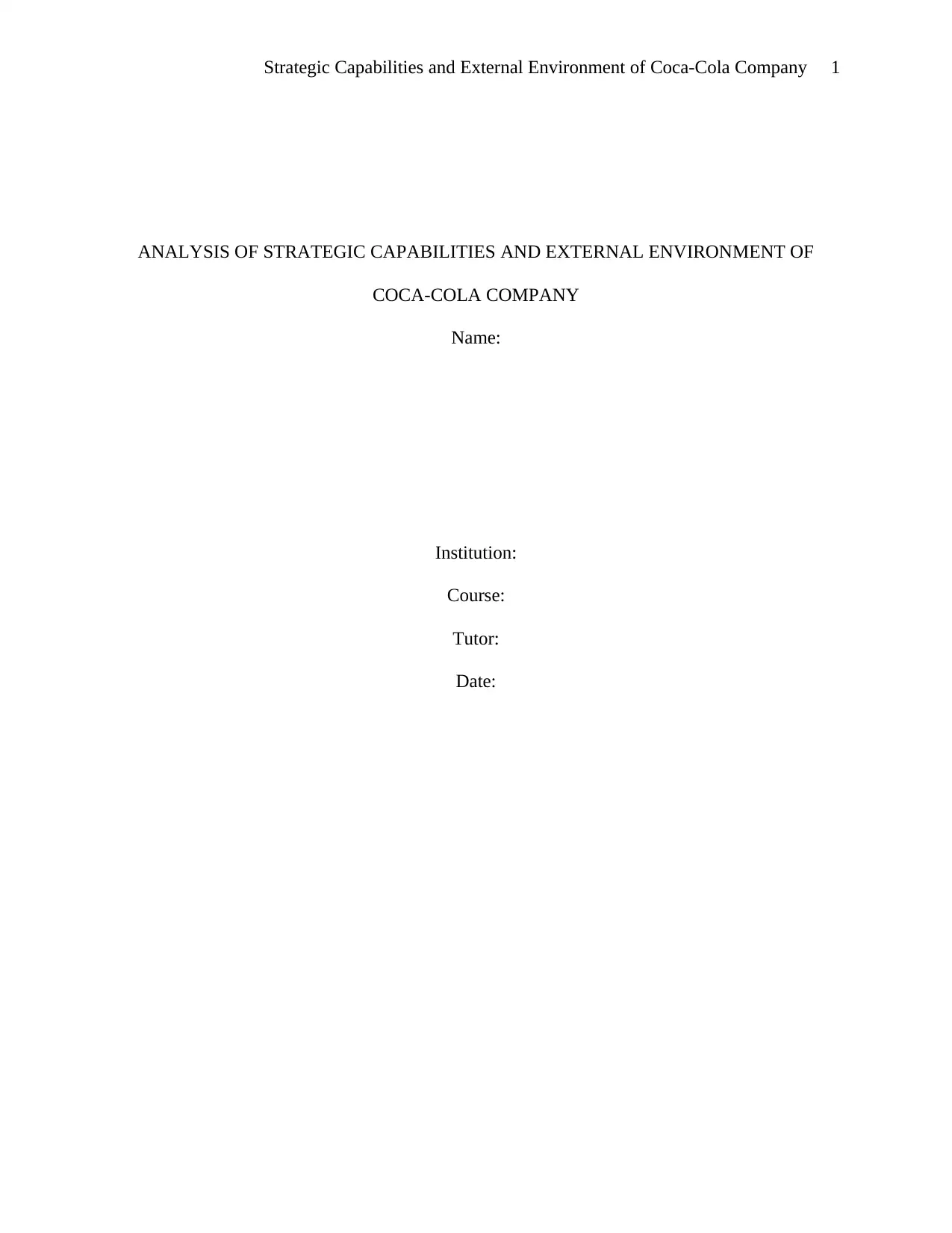
Strategic Capabilities and External Environment of Coca-Cola Company 1
ANALYSIS OF STRATEGIC CAPABILITIES AND EXTERNAL ENVIRONMENT OF
COCA-COLA COMPANY
Name:
Institution:
Course:
Tutor:
Date:
ANALYSIS OF STRATEGIC CAPABILITIES AND EXTERNAL ENVIRONMENT OF
COCA-COLA COMPANY
Name:
Institution:
Course:
Tutor:
Date:
Paraphrase This Document
Need a fresh take? Get an instant paraphrase of this document with our AI Paraphraser
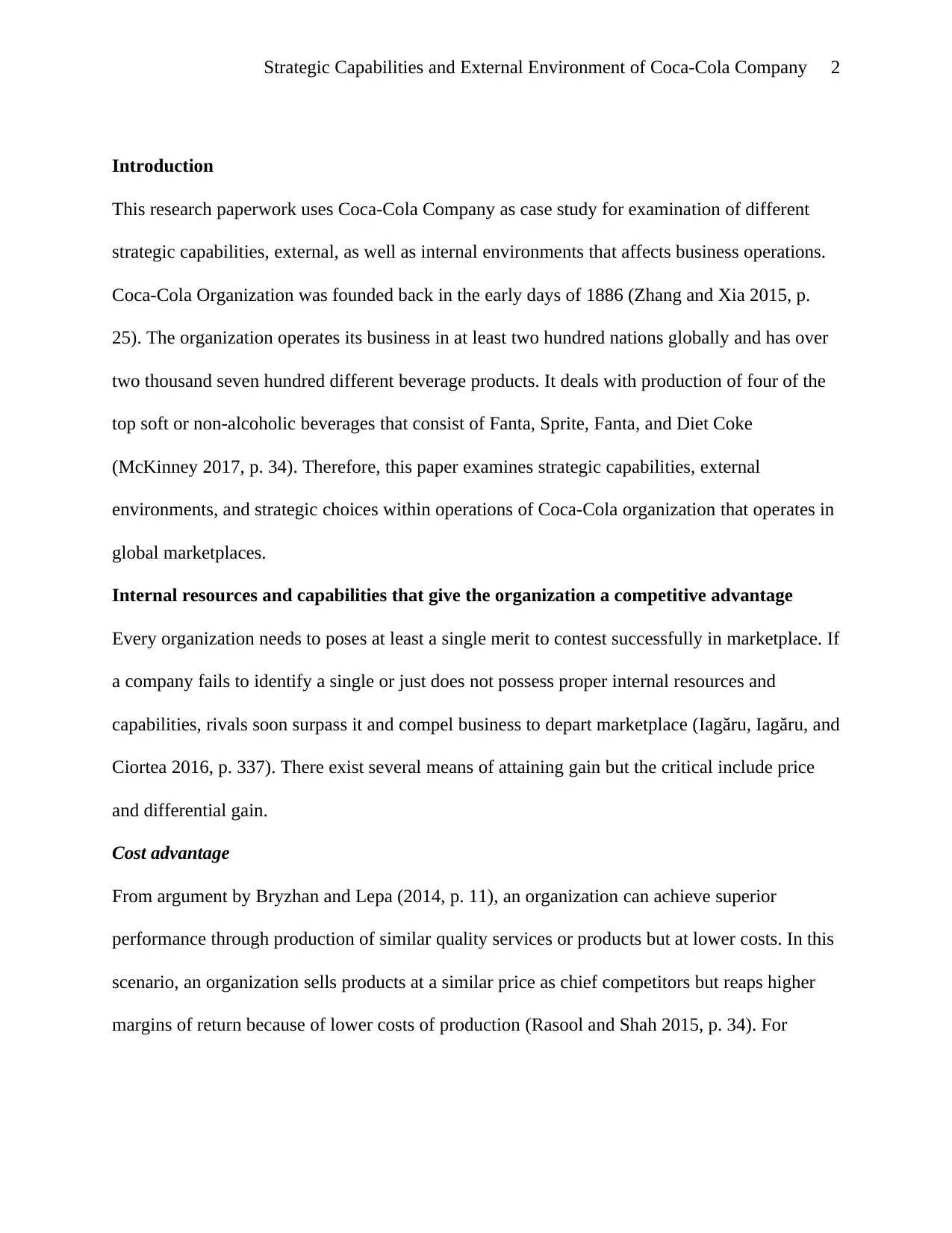
Strategic Capabilities and External Environment of Coca-Cola Company 2
Introduction
This research paperwork uses Coca-Cola Company as case study for examination of different
strategic capabilities, external, as well as internal environments that affects business operations.
Coca-Cola Organization was founded back in the early days of 1886 (Zhang and Xia 2015, p.
25). The organization operates its business in at least two hundred nations globally and has over
two thousand seven hundred different beverage products. It deals with production of four of the
top soft or non-alcoholic beverages that consist of Fanta, Sprite, Fanta, and Diet Coke
(McKinney 2017, p. 34). Therefore, this paper examines strategic capabilities, external
environments, and strategic choices within operations of Coca-Cola organization that operates in
global marketplaces.
Internal resources and capabilities that give the organization a competitive advantage
Every organization needs to poses at least a single merit to contest successfully in marketplace. If
a company fails to identify a single or just does not possess proper internal resources and
capabilities, rivals soon surpass it and compel business to depart marketplace (Iagăru, Iagăru, and
Ciortea 2016, p. 337). There exist several means of attaining gain but the critical include price
and differential gain.
Cost advantage
From argument by Bryzhan and Lepa (2014, p. 11), an organization can achieve superior
performance through production of similar quality services or products but at lower costs. In this
scenario, an organization sells products at a similar price as chief competitors but reaps higher
margins of return because of lower costs of production (Rasool and Shah 2015, p. 34). For
Introduction
This research paperwork uses Coca-Cola Company as case study for examination of different
strategic capabilities, external, as well as internal environments that affects business operations.
Coca-Cola Organization was founded back in the early days of 1886 (Zhang and Xia 2015, p.
25). The organization operates its business in at least two hundred nations globally and has over
two thousand seven hundred different beverage products. It deals with production of four of the
top soft or non-alcoholic beverages that consist of Fanta, Sprite, Fanta, and Diet Coke
(McKinney 2017, p. 34). Therefore, this paper examines strategic capabilities, external
environments, and strategic choices within operations of Coca-Cola organization that operates in
global marketplaces.
Internal resources and capabilities that give the organization a competitive advantage
Every organization needs to poses at least a single merit to contest successfully in marketplace. If
a company fails to identify a single or just does not possess proper internal resources and
capabilities, rivals soon surpass it and compel business to depart marketplace (Iagăru, Iagăru, and
Ciortea 2016, p. 337). There exist several means of attaining gain but the critical include price
and differential gain.
Cost advantage
From argument by Bryzhan and Lepa (2014, p. 11), an organization can achieve superior
performance through production of similar quality services or products but at lower costs. In this
scenario, an organization sells products at a similar price as chief competitors but reaps higher
margins of return because of lower costs of production (Rasool and Shah 2015, p. 34). For
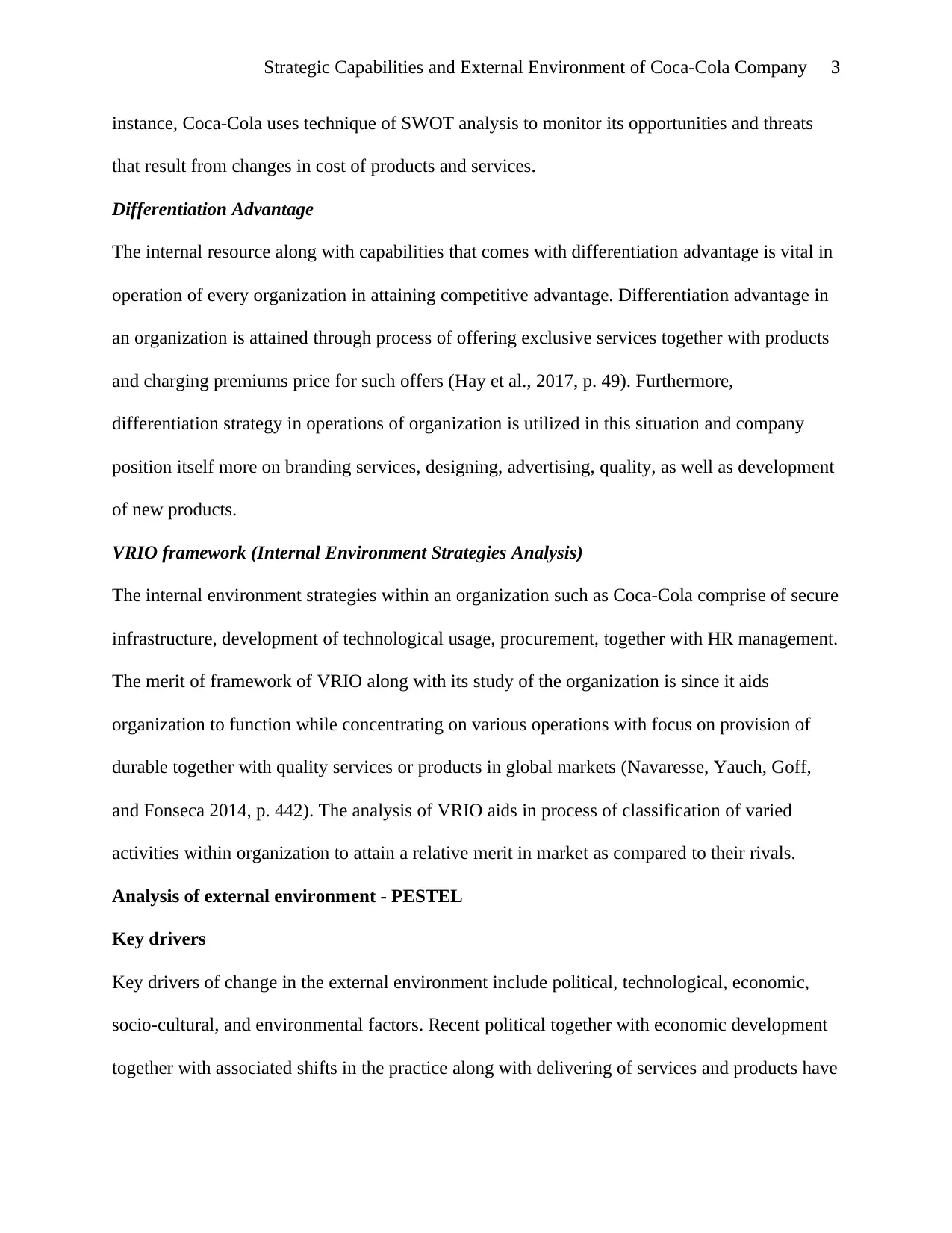
Strategic Capabilities and External Environment of Coca-Cola Company 3
instance, Coca-Cola uses technique of SWOT analysis to monitor its opportunities and threats
that result from changes in cost of products and services.
Differentiation Advantage
The internal resource along with capabilities that comes with differentiation advantage is vital in
operation of every organization in attaining competitive advantage. Differentiation advantage in
an organization is attained through process of offering exclusive services together with products
and charging premiums price for such offers (Hay et al., 2017, p. 49). Furthermore,
differentiation strategy in operations of organization is utilized in this situation and company
position itself more on branding services, designing, advertising, quality, as well as development
of new products.
VRIO framework (Internal Environment Strategies Analysis)
The internal environment strategies within an organization such as Coca-Cola comprise of secure
infrastructure, development of technological usage, procurement, together with HR management.
The merit of framework of VRIO along with its study of the organization is since it aids
organization to function while concentrating on various operations with focus on provision of
durable together with quality services or products in global markets (Navaresse, Yauch, Goff,
and Fonseca 2014, p. 442). The analysis of VRIO aids in process of classification of varied
activities within organization to attain a relative merit in market as compared to their rivals.
Analysis of external environment - PESTEL
Key drivers
Key drivers of change in the external environment include political, technological, economic,
socio-cultural, and environmental factors. Recent political together with economic development
together with associated shifts in the practice along with delivering of services and products have
instance, Coca-Cola uses technique of SWOT analysis to monitor its opportunities and threats
that result from changes in cost of products and services.
Differentiation Advantage
The internal resource along with capabilities that comes with differentiation advantage is vital in
operation of every organization in attaining competitive advantage. Differentiation advantage in
an organization is attained through process of offering exclusive services together with products
and charging premiums price for such offers (Hay et al., 2017, p. 49). Furthermore,
differentiation strategy in operations of organization is utilized in this situation and company
position itself more on branding services, designing, advertising, quality, as well as development
of new products.
VRIO framework (Internal Environment Strategies Analysis)
The internal environment strategies within an organization such as Coca-Cola comprise of secure
infrastructure, development of technological usage, procurement, together with HR management.
The merit of framework of VRIO along with its study of the organization is since it aids
organization to function while concentrating on various operations with focus on provision of
durable together with quality services or products in global markets (Navaresse, Yauch, Goff,
and Fonseca 2014, p. 442). The analysis of VRIO aids in process of classification of varied
activities within organization to attain a relative merit in market as compared to their rivals.
Analysis of external environment - PESTEL
Key drivers
Key drivers of change in the external environment include political, technological, economic,
socio-cultural, and environmental factors. Recent political together with economic development
together with associated shifts in the practice along with delivering of services and products have
⊘ This is a preview!⊘
Do you want full access?
Subscribe today to unlock all pages.

Trusted by 1+ million students worldwide
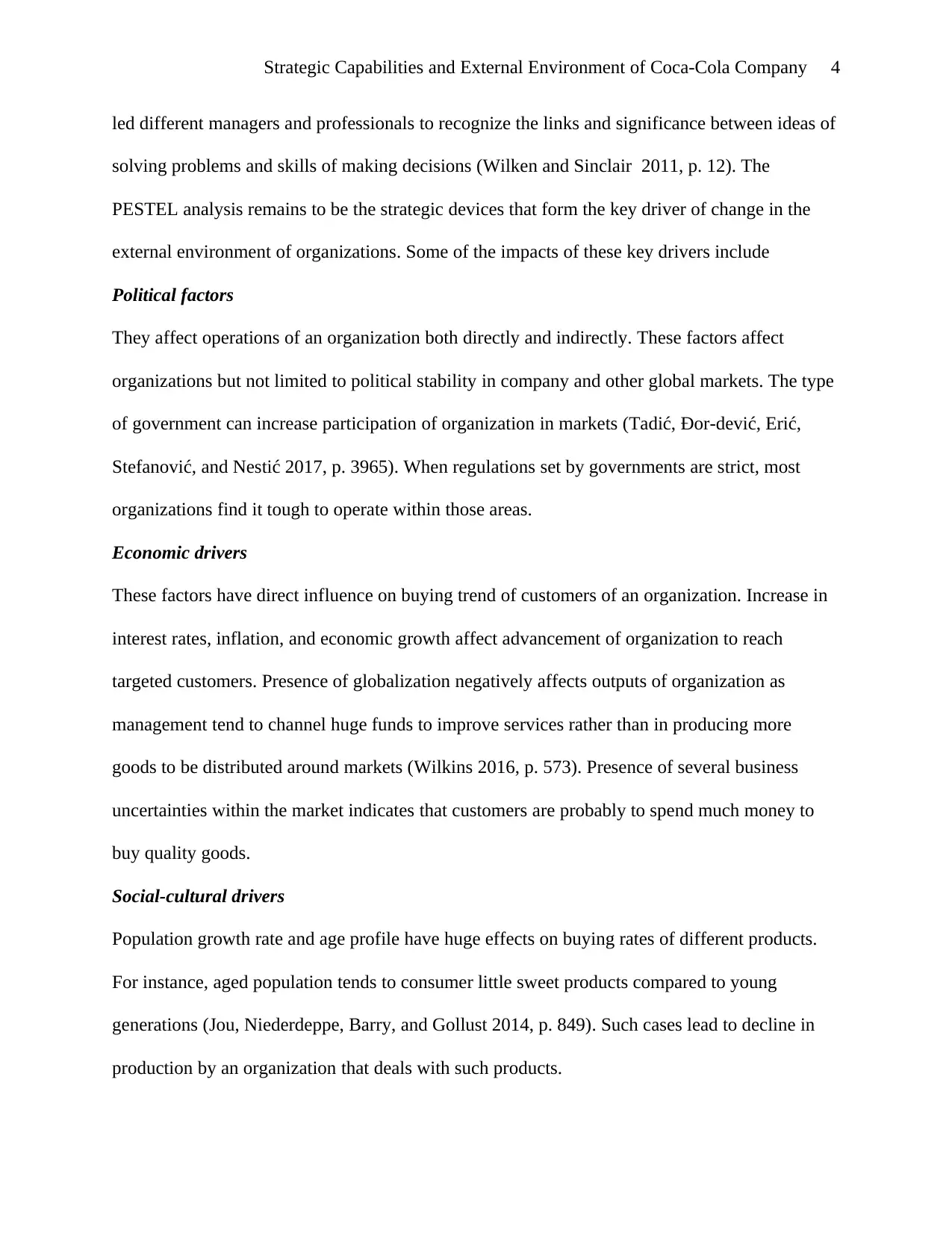
Strategic Capabilities and External Environment of Coca-Cola Company 4
led different managers and professionals to recognize the links and significance between ideas of
solving problems and skills of making decisions (Wilken and Sinclair 2011, p. 12). The
PESTEL analysis remains to be the strategic devices that form the key driver of change in the
external environment of organizations. Some of the impacts of these key drivers include
Political factors
They affect operations of an organization both directly and indirectly. These factors affect
organizations but not limited to political stability in company and other global markets. The type
of government can increase participation of organization in markets (Tadić, Ðor-dević, Erić,
Stefanović, and Nestić 2017, p. 3965). When regulations set by governments are strict, most
organizations find it tough to operate within those areas.
Economic drivers
These factors have direct influence on buying trend of customers of an organization. Increase in
interest rates, inflation, and economic growth affect advancement of organization to reach
targeted customers. Presence of globalization negatively affects outputs of organization as
management tend to channel huge funds to improve services rather than in producing more
goods to be distributed around markets (Wilkins 2016, p. 573). Presence of several business
uncertainties within the market indicates that customers are probably to spend much money to
buy quality goods.
Social-cultural drivers
Population growth rate and age profile have huge effects on buying rates of different products.
For instance, aged population tends to consumer little sweet products compared to young
generations (Jou, Niederdeppe, Barry, and Gollust 2014, p. 849). Such cases lead to decline in
production by an organization that deals with such products.
led different managers and professionals to recognize the links and significance between ideas of
solving problems and skills of making decisions (Wilken and Sinclair 2011, p. 12). The
PESTEL analysis remains to be the strategic devices that form the key driver of change in the
external environment of organizations. Some of the impacts of these key drivers include
Political factors
They affect operations of an organization both directly and indirectly. These factors affect
organizations but not limited to political stability in company and other global markets. The type
of government can increase participation of organization in markets (Tadić, Ðor-dević, Erić,
Stefanović, and Nestić 2017, p. 3965). When regulations set by governments are strict, most
organizations find it tough to operate within those areas.
Economic drivers
These factors have direct influence on buying trend of customers of an organization. Increase in
interest rates, inflation, and economic growth affect advancement of organization to reach
targeted customers. Presence of globalization negatively affects outputs of organization as
management tend to channel huge funds to improve services rather than in producing more
goods to be distributed around markets (Wilkins 2016, p. 573). Presence of several business
uncertainties within the market indicates that customers are probably to spend much money to
buy quality goods.
Social-cultural drivers
Population growth rate and age profile have huge effects on buying rates of different products.
For instance, aged population tends to consumer little sweet products compared to young
generations (Jou, Niederdeppe, Barry, and Gollust 2014, p. 849). Such cases lead to decline in
production by an organization that deals with such products.
Paraphrase This Document
Need a fresh take? Get an instant paraphrase of this document with our AI Paraphraser
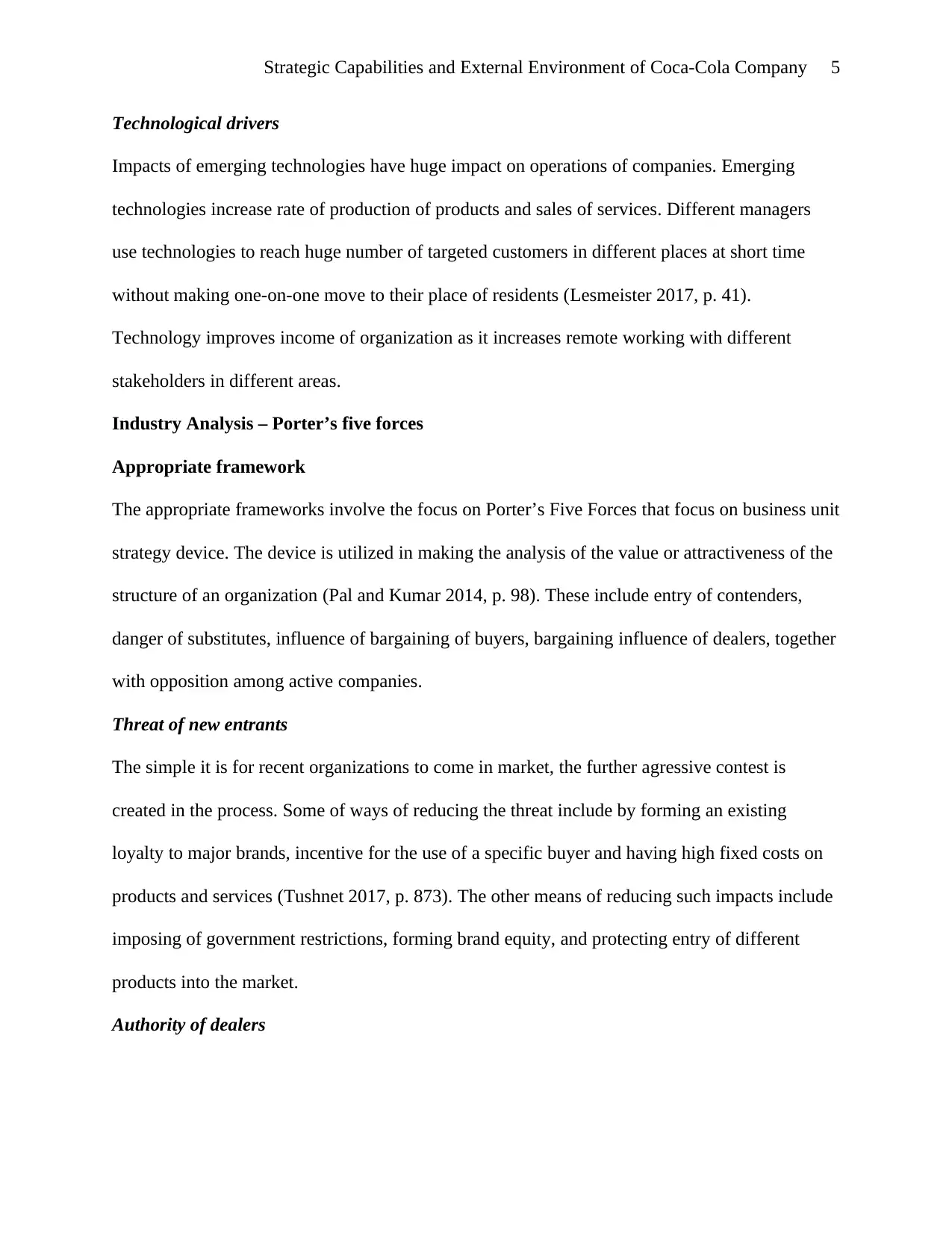
Strategic Capabilities and External Environment of Coca-Cola Company 5
Technological drivers
Impacts of emerging technologies have huge impact on operations of companies. Emerging
technologies increase rate of production of products and sales of services. Different managers
use technologies to reach huge number of targeted customers in different places at short time
without making one-on-one move to their place of residents (Lesmeister 2017, p. 41).
Technology improves income of organization as it increases remote working with different
stakeholders in different areas.
Industry Analysis – Porter’s five forces
Appropriate framework
The appropriate frameworks involve the focus on Porter’s Five Forces that focus on business unit
strategy device. The device is utilized in making the analysis of the value or attractiveness of the
structure of an organization (Pal and Kumar 2014, p. 98). These include entry of contenders,
danger of substitutes, influence of bargaining of buyers, bargaining influence of dealers, together
with opposition among active companies.
Threat of new entrants
The simple it is for recent organizations to come in market, the further agressive contest is
created in the process. Some of ways of reducing the threat include by forming an existing
loyalty to major brands, incentive for the use of a specific buyer and having high fixed costs on
products and services (Tushnet 2017, p. 873). The other means of reducing such impacts include
imposing of government restrictions, forming brand equity, and protecting entry of different
products into the market.
Authority of dealers
Technological drivers
Impacts of emerging technologies have huge impact on operations of companies. Emerging
technologies increase rate of production of products and sales of services. Different managers
use technologies to reach huge number of targeted customers in different places at short time
without making one-on-one move to their place of residents (Lesmeister 2017, p. 41).
Technology improves income of organization as it increases remote working with different
stakeholders in different areas.
Industry Analysis – Porter’s five forces
Appropriate framework
The appropriate frameworks involve the focus on Porter’s Five Forces that focus on business unit
strategy device. The device is utilized in making the analysis of the value or attractiveness of the
structure of an organization (Pal and Kumar 2014, p. 98). These include entry of contenders,
danger of substitutes, influence of bargaining of buyers, bargaining influence of dealers, together
with opposition among active companies.
Threat of new entrants
The simple it is for recent organizations to come in market, the further agressive contest is
created in the process. Some of ways of reducing the threat include by forming an existing
loyalty to major brands, incentive for the use of a specific buyer and having high fixed costs on
products and services (Tushnet 2017, p. 873). The other means of reducing such impacts include
imposing of government restrictions, forming brand equity, and protecting entry of different
products into the market.
Authority of dealers
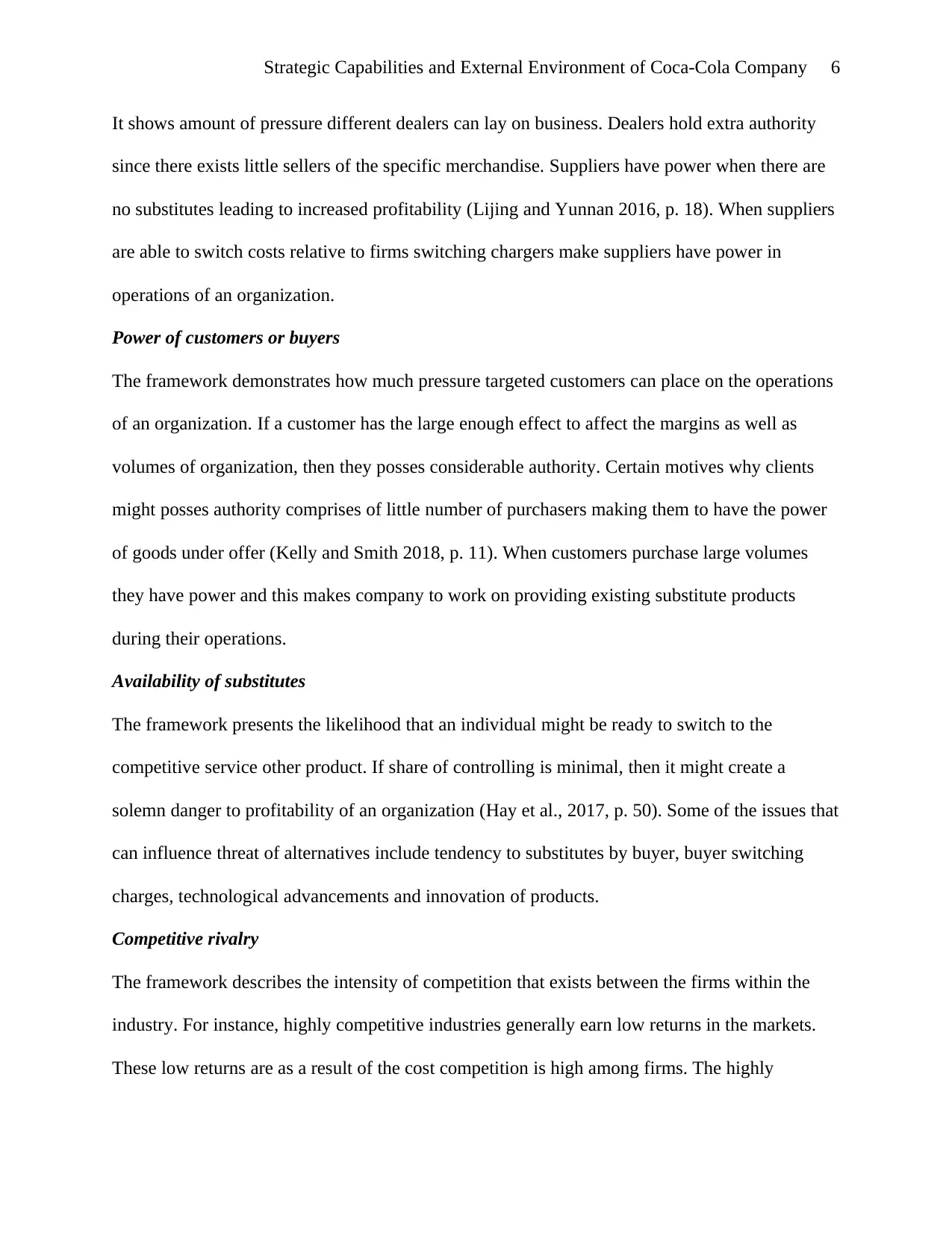
Strategic Capabilities and External Environment of Coca-Cola Company 6
It shows amount of pressure different dealers can lay on business. Dealers hold extra authority
since there exists little sellers of the specific merchandise. Suppliers have power when there are
no substitutes leading to increased profitability (Lijing and Yunnan 2016, p. 18). When suppliers
are able to switch costs relative to firms switching chargers make suppliers have power in
operations of an organization.
Power of customers or buyers
The framework demonstrates how much pressure targeted customers can place on the operations
of an organization. If a customer has the large enough effect to affect the margins as well as
volumes of organization, then they posses considerable authority. Certain motives why clients
might posses authority comprises of little number of purchasers making them to have the power
of goods under offer (Kelly and Smith 2018, p. 11). When customers purchase large volumes
they have power and this makes company to work on providing existing substitute products
during their operations.
Availability of substitutes
The framework presents the likelihood that an individual might be ready to switch to the
competitive service other product. If share of controlling is minimal, then it might create a
solemn danger to profitability of an organization (Hay et al., 2017, p. 50). Some of the issues that
can influence threat of alternatives include tendency to substitutes by buyer, buyer switching
charges, technological advancements and innovation of products.
Competitive rivalry
The framework describes the intensity of competition that exists between the firms within the
industry. For instance, highly competitive industries generally earn low returns in the markets.
These low returns are as a result of the cost competition is high among firms. The highly
It shows amount of pressure different dealers can lay on business. Dealers hold extra authority
since there exists little sellers of the specific merchandise. Suppliers have power when there are
no substitutes leading to increased profitability (Lijing and Yunnan 2016, p. 18). When suppliers
are able to switch costs relative to firms switching chargers make suppliers have power in
operations of an organization.
Power of customers or buyers
The framework demonstrates how much pressure targeted customers can place on the operations
of an organization. If a customer has the large enough effect to affect the margins as well as
volumes of organization, then they posses considerable authority. Certain motives why clients
might posses authority comprises of little number of purchasers making them to have the power
of goods under offer (Kelly and Smith 2018, p. 11). When customers purchase large volumes
they have power and this makes company to work on providing existing substitute products
during their operations.
Availability of substitutes
The framework presents the likelihood that an individual might be ready to switch to the
competitive service other product. If share of controlling is minimal, then it might create a
solemn danger to profitability of an organization (Hay et al., 2017, p. 50). Some of the issues that
can influence threat of alternatives include tendency to substitutes by buyer, buyer switching
charges, technological advancements and innovation of products.
Competitive rivalry
The framework describes the intensity of competition that exists between the firms within the
industry. For instance, highly competitive industries generally earn low returns in the markets.
These low returns are as a result of the cost competition is high among firms. The highly
⊘ This is a preview!⊘
Do you want full access?
Subscribe today to unlock all pages.

Trusted by 1+ million students worldwide
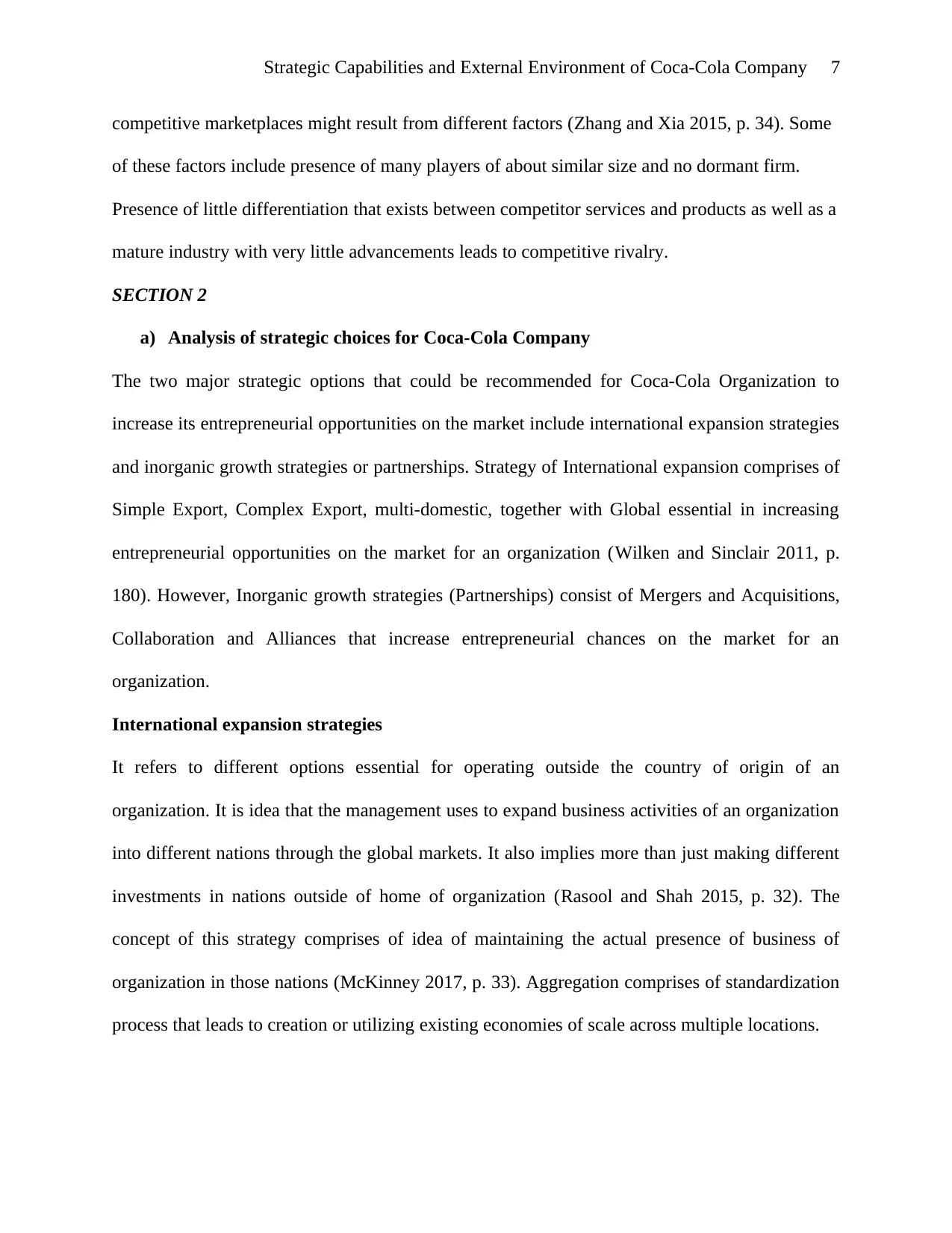
Strategic Capabilities and External Environment of Coca-Cola Company 7
competitive marketplaces might result from different factors (Zhang and Xia 2015, p. 34). Some
of these factors include presence of many players of about similar size and no dormant firm.
Presence of little differentiation that exists between competitor services and products as well as a
mature industry with very little advancements leads to competitive rivalry.
SECTION 2
a) Analysis of strategic choices for Coca-Cola Company
The two major strategic options that could be recommended for Coca-Cola Organization to
increase its entrepreneurial opportunities on the market include international expansion strategies
and inorganic growth strategies or partnerships. Strategy of International expansion comprises of
Simple Export, Complex Export, multi-domestic, together with Global essential in increasing
entrepreneurial opportunities on the market for an organization (Wilken and Sinclair 2011, p.
180). However, Inorganic growth strategies (Partnerships) consist of Mergers and Acquisitions,
Collaboration and Alliances that increase entrepreneurial chances on the market for an
organization.
International expansion strategies
It refers to different options essential for operating outside the country of origin of an
organization. It is idea that the management uses to expand business activities of an organization
into different nations through the global markets. It also implies more than just making different
investments in nations outside of home of organization (Rasool and Shah 2015, p. 32). The
concept of this strategy comprises of idea of maintaining the actual presence of business of
organization in those nations (McKinney 2017, p. 33). Aggregation comprises of standardization
process that leads to creation or utilizing existing economies of scale across multiple locations.
competitive marketplaces might result from different factors (Zhang and Xia 2015, p. 34). Some
of these factors include presence of many players of about similar size and no dormant firm.
Presence of little differentiation that exists between competitor services and products as well as a
mature industry with very little advancements leads to competitive rivalry.
SECTION 2
a) Analysis of strategic choices for Coca-Cola Company
The two major strategic options that could be recommended for Coca-Cola Organization to
increase its entrepreneurial opportunities on the market include international expansion strategies
and inorganic growth strategies or partnerships. Strategy of International expansion comprises of
Simple Export, Complex Export, multi-domestic, together with Global essential in increasing
entrepreneurial opportunities on the market for an organization (Wilken and Sinclair 2011, p.
180). However, Inorganic growth strategies (Partnerships) consist of Mergers and Acquisitions,
Collaboration and Alliances that increase entrepreneurial chances on the market for an
organization.
International expansion strategies
It refers to different options essential for operating outside the country of origin of an
organization. It is idea that the management uses to expand business activities of an organization
into different nations through the global markets. It also implies more than just making different
investments in nations outside of home of organization (Rasool and Shah 2015, p. 32). The
concept of this strategy comprises of idea of maintaining the actual presence of business of
organization in those nations (McKinney 2017, p. 33). Aggregation comprises of standardization
process that leads to creation or utilizing existing economies of scale across multiple locations.
Paraphrase This Document
Need a fresh take? Get an instant paraphrase of this document with our AI Paraphraser
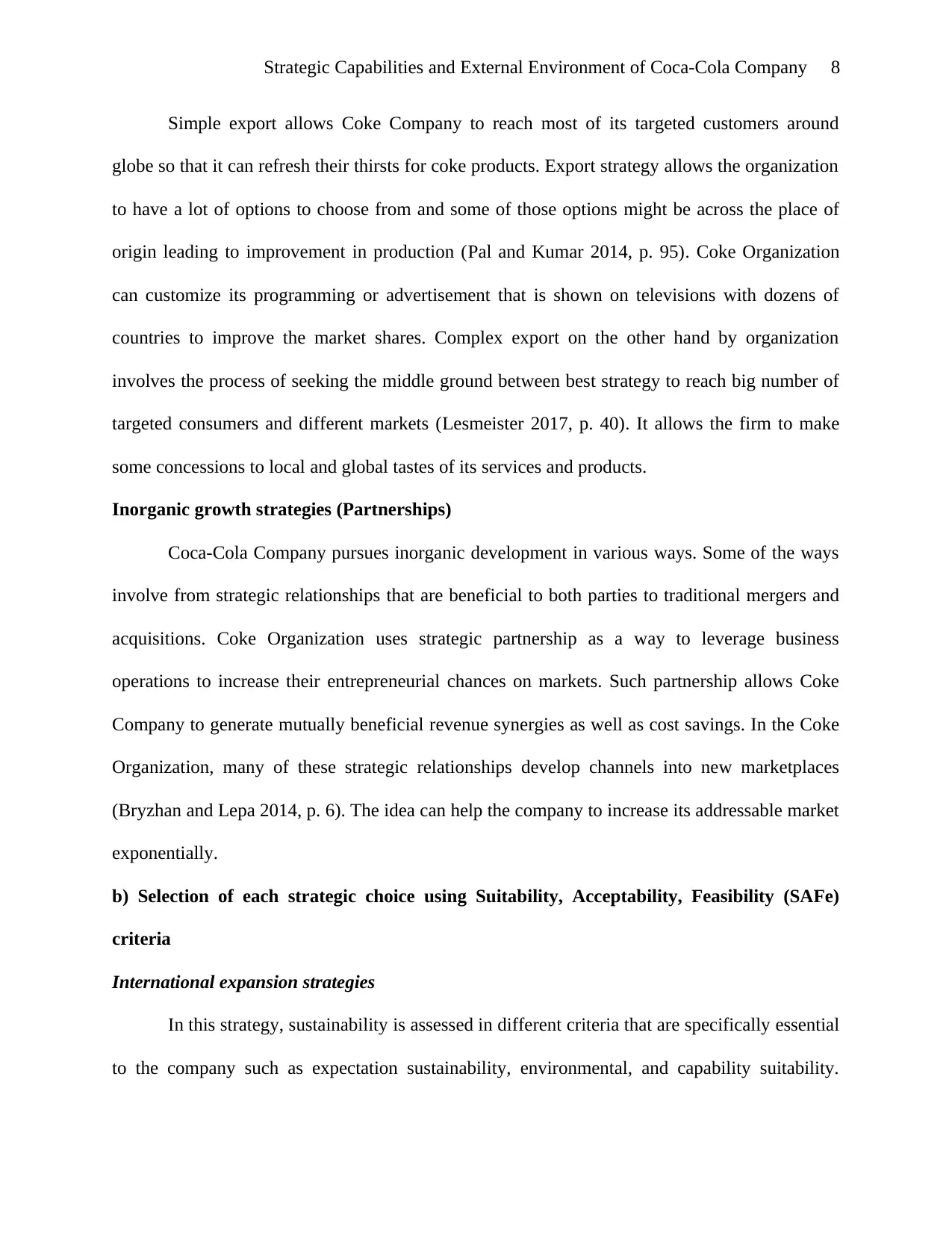
Strategic Capabilities and External Environment of Coca-Cola Company 8
Simple export allows Coke Company to reach most of its targeted customers around
globe so that it can refresh their thirsts for coke products. Export strategy allows the organization
to have a lot of options to choose from and some of those options might be across the place of
origin leading to improvement in production (Pal and Kumar 2014, p. 95). Coke Organization
can customize its programming or advertisement that is shown on televisions with dozens of
countries to improve the market shares. Complex export on the other hand by organization
involves the process of seeking the middle ground between best strategy to reach big number of
targeted consumers and different markets (Lesmeister 2017, p. 40). It allows the firm to make
some concessions to local and global tastes of its services and products.
Inorganic growth strategies (Partnerships)
Coca-Cola Company pursues inorganic development in various ways. Some of the ways
involve from strategic relationships that are beneficial to both parties to traditional mergers and
acquisitions. Coke Organization uses strategic partnership as a way to leverage business
operations to increase their entrepreneurial chances on markets. Such partnership allows Coke
Company to generate mutually beneficial revenue synergies as well as cost savings. In the Coke
Organization, many of these strategic relationships develop channels into new marketplaces
(Bryzhan and Lepa 2014, p. 6). The idea can help the company to increase its addressable market
exponentially.
b) Selection of each strategic choice using Suitability, Acceptability, Feasibility (SAFe)
criteria
International expansion strategies
In this strategy, sustainability is assessed in different criteria that are specifically essential
to the company such as expectation sustainability, environmental, and capability suitability.
Simple export allows Coke Company to reach most of its targeted customers around
globe so that it can refresh their thirsts for coke products. Export strategy allows the organization
to have a lot of options to choose from and some of those options might be across the place of
origin leading to improvement in production (Pal and Kumar 2014, p. 95). Coke Organization
can customize its programming or advertisement that is shown on televisions with dozens of
countries to improve the market shares. Complex export on the other hand by organization
involves the process of seeking the middle ground between best strategy to reach big number of
targeted consumers and different markets (Lesmeister 2017, p. 40). It allows the firm to make
some concessions to local and global tastes of its services and products.
Inorganic growth strategies (Partnerships)
Coca-Cola Company pursues inorganic development in various ways. Some of the ways
involve from strategic relationships that are beneficial to both parties to traditional mergers and
acquisitions. Coke Organization uses strategic partnership as a way to leverage business
operations to increase their entrepreneurial chances on markets. Such partnership allows Coke
Company to generate mutually beneficial revenue synergies as well as cost savings. In the Coke
Organization, many of these strategic relationships develop channels into new marketplaces
(Bryzhan and Lepa 2014, p. 6). The idea can help the company to increase its addressable market
exponentially.
b) Selection of each strategic choice using Suitability, Acceptability, Feasibility (SAFe)
criteria
International expansion strategies
In this strategy, sustainability is assessed in different criteria that are specifically essential
to the company such as expectation sustainability, environmental, and capability suitability.
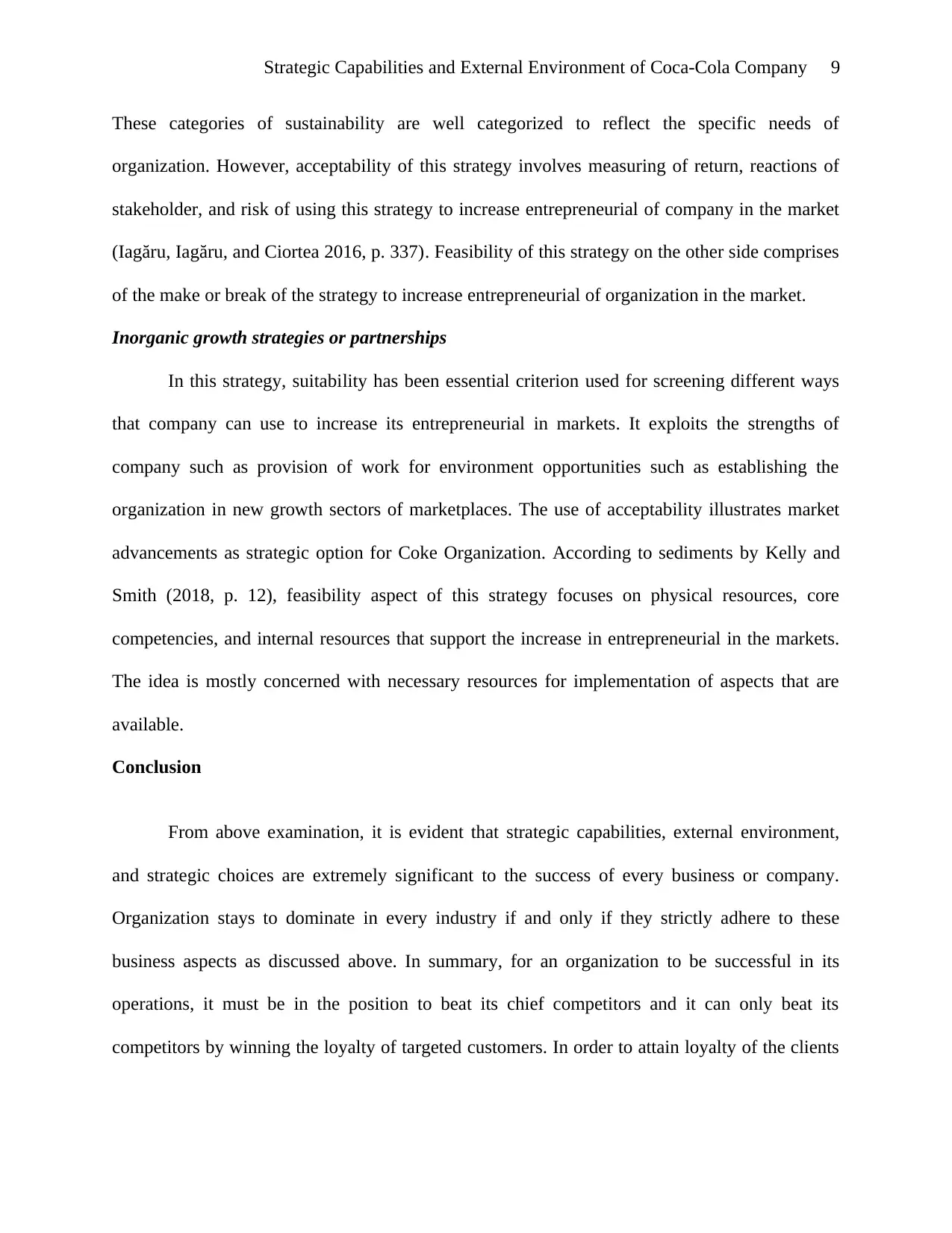
Strategic Capabilities and External Environment of Coca-Cola Company 9
These categories of sustainability are well categorized to reflect the specific needs of
organization. However, acceptability of this strategy involves measuring of return, reactions of
stakeholder, and risk of using this strategy to increase entrepreneurial of company in the market
(Iagăru, Iagăru, and Ciortea 2016, p. 337). Feasibility of this strategy on the other side comprises
of the make or break of the strategy to increase entrepreneurial of organization in the market.
Inorganic growth strategies or partnerships
In this strategy, suitability has been essential criterion used for screening different ways
that company can use to increase its entrepreneurial in markets. It exploits the strengths of
company such as provision of work for environment opportunities such as establishing the
organization in new growth sectors of marketplaces. The use of acceptability illustrates market
advancements as strategic option for Coke Organization. According to sediments by Kelly and
Smith (2018, p. 12), feasibility aspect of this strategy focuses on physical resources, core
competencies, and internal resources that support the increase in entrepreneurial in the markets.
The idea is mostly concerned with necessary resources for implementation of aspects that are
available.
Conclusion
From above examination, it is evident that strategic capabilities, external environment,
and strategic choices are extremely significant to the success of every business or company.
Organization stays to dominate in every industry if and only if they strictly adhere to these
business aspects as discussed above. In summary, for an organization to be successful in its
operations, it must be in the position to beat its chief competitors and it can only beat its
competitors by winning the loyalty of targeted customers. In order to attain loyalty of the clients
These categories of sustainability are well categorized to reflect the specific needs of
organization. However, acceptability of this strategy involves measuring of return, reactions of
stakeholder, and risk of using this strategy to increase entrepreneurial of company in the market
(Iagăru, Iagăru, and Ciortea 2016, p. 337). Feasibility of this strategy on the other side comprises
of the make or break of the strategy to increase entrepreneurial of organization in the market.
Inorganic growth strategies or partnerships
In this strategy, suitability has been essential criterion used for screening different ways
that company can use to increase its entrepreneurial in markets. It exploits the strengths of
company such as provision of work for environment opportunities such as establishing the
organization in new growth sectors of marketplaces. The use of acceptability illustrates market
advancements as strategic option for Coke Organization. According to sediments by Kelly and
Smith (2018, p. 12), feasibility aspect of this strategy focuses on physical resources, core
competencies, and internal resources that support the increase in entrepreneurial in the markets.
The idea is mostly concerned with necessary resources for implementation of aspects that are
available.
Conclusion
From above examination, it is evident that strategic capabilities, external environment,
and strategic choices are extremely significant to the success of every business or company.
Organization stays to dominate in every industry if and only if they strictly adhere to these
business aspects as discussed above. In summary, for an organization to be successful in its
operations, it must be in the position to beat its chief competitors and it can only beat its
competitors by winning the loyalty of targeted customers. In order to attain loyalty of the clients
⊘ This is a preview!⊘
Do you want full access?
Subscribe today to unlock all pages.

Trusted by 1+ million students worldwide
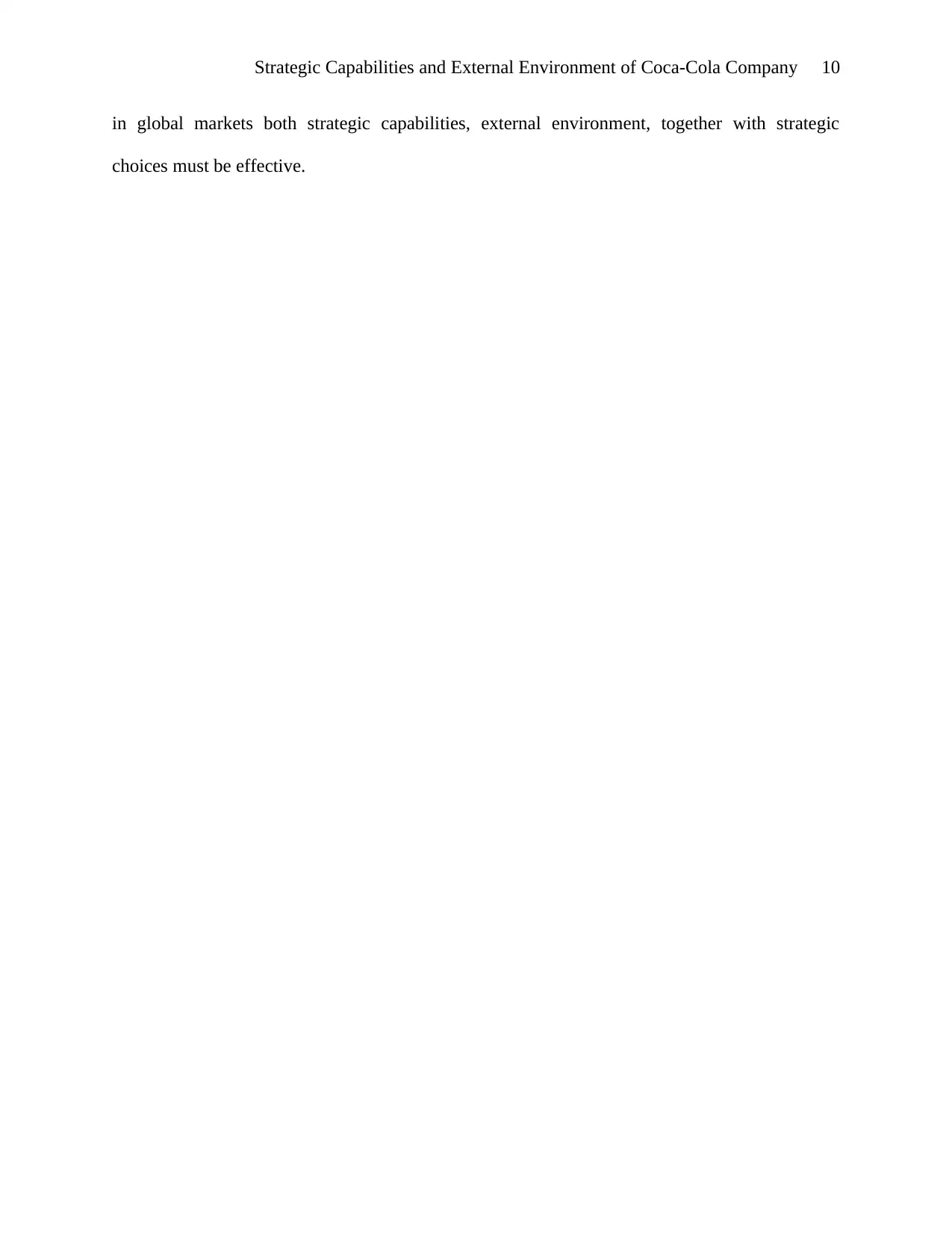
Strategic Capabilities and External Environment of Coca-Cola Company 10
in global markets both strategic capabilities, external environment, together with strategic
choices must be effective.
in global markets both strategic capabilities, external environment, together with strategic
choices must be effective.
Paraphrase This Document
Need a fresh take? Get an instant paraphrase of this document with our AI Paraphraser
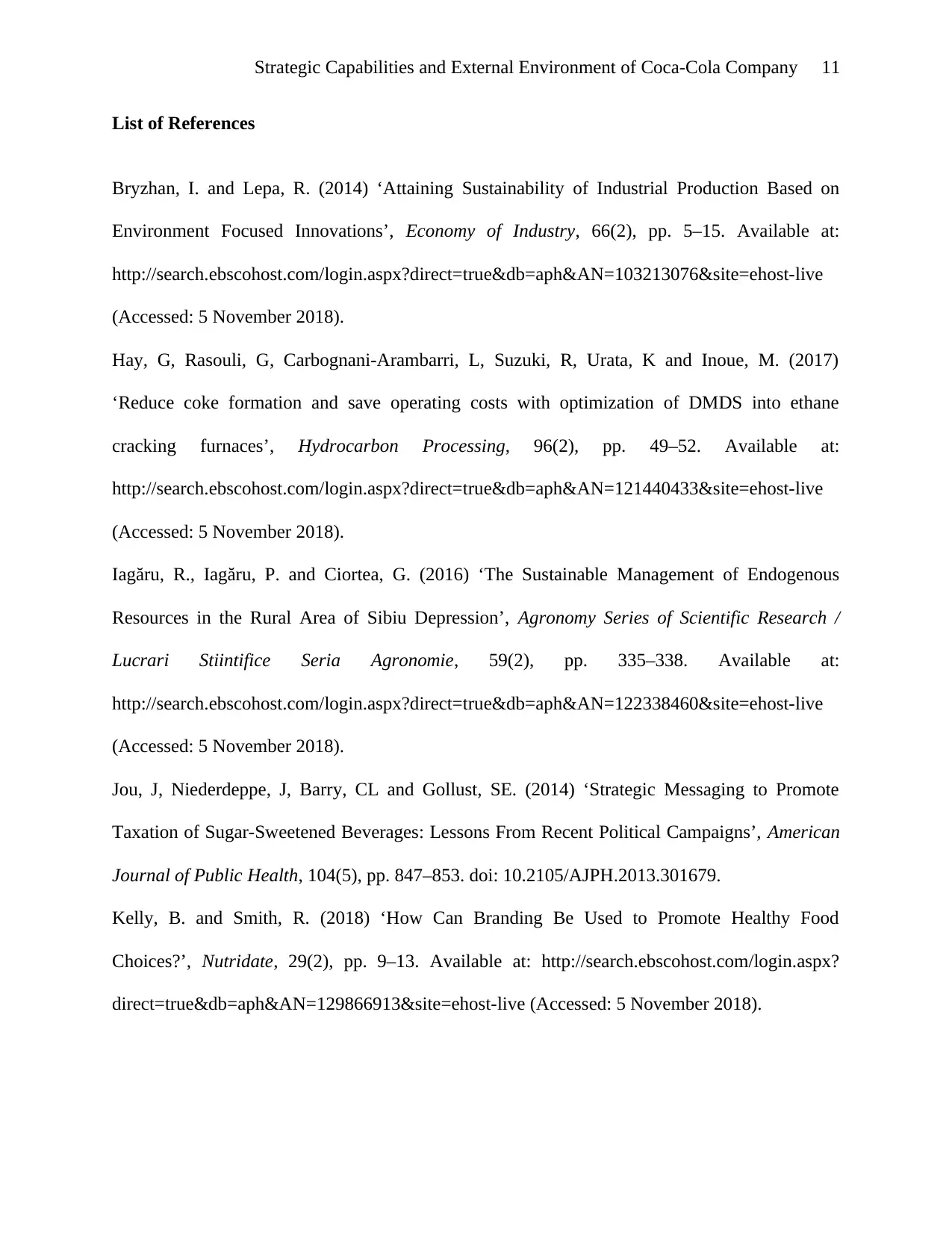
Strategic Capabilities and External Environment of Coca-Cola Company 11
List of References
Bryzhan, I. and Lepa, R. (2014) ‘Attaining Sustainability of Industrial Production Based on
Environment Focused Innovations’, Economy of Industry, 66(2), pp. 5–15. Available at:
http://search.ebscohost.com/login.aspx?direct=true&db=aph&AN=103213076&site=ehost-live
(Accessed: 5 November 2018).
Hay, G, Rasouli, G, Carbognani-Arambarri, L, Suzuki, R, Urata, K and Inoue, M. (2017)
‘Reduce coke formation and save operating costs with optimization of DMDS into ethane
cracking furnaces’, Hydrocarbon Processing, 96(2), pp. 49–52. Available at:
http://search.ebscohost.com/login.aspx?direct=true&db=aph&AN=121440433&site=ehost-live
(Accessed: 5 November 2018).
Iagăru, R., Iagăru, P. and Ciortea, G. (2016) ‘The Sustainable Management of Endogenous
Resources in the Rural Area of Sibiu Depression’, Agronomy Series of Scientific Research /
Lucrari Stiintifice Seria Agronomie, 59(2), pp. 335–338. Available at:
http://search.ebscohost.com/login.aspx?direct=true&db=aph&AN=122338460&site=ehost-live
(Accessed: 5 November 2018).
Jou, J, Niederdeppe, J, Barry, CL and Gollust, SE. (2014) ‘Strategic Messaging to Promote
Taxation of Sugar-Sweetened Beverages: Lessons From Recent Political Campaigns’, American
Journal of Public Health, 104(5), pp. 847–853. doi: 10.2105/AJPH.2013.301679.
Kelly, B. and Smith, R. (2018) ‘How Can Branding Be Used to Promote Healthy Food
Choices?’, Nutridate, 29(2), pp. 9–13. Available at: http://search.ebscohost.com/login.aspx?
direct=true&db=aph&AN=129866913&site=ehost-live (Accessed: 5 November 2018).
List of References
Bryzhan, I. and Lepa, R. (2014) ‘Attaining Sustainability of Industrial Production Based on
Environment Focused Innovations’, Economy of Industry, 66(2), pp. 5–15. Available at:
http://search.ebscohost.com/login.aspx?direct=true&db=aph&AN=103213076&site=ehost-live
(Accessed: 5 November 2018).
Hay, G, Rasouli, G, Carbognani-Arambarri, L, Suzuki, R, Urata, K and Inoue, M. (2017)
‘Reduce coke formation and save operating costs with optimization of DMDS into ethane
cracking furnaces’, Hydrocarbon Processing, 96(2), pp. 49–52. Available at:
http://search.ebscohost.com/login.aspx?direct=true&db=aph&AN=121440433&site=ehost-live
(Accessed: 5 November 2018).
Iagăru, R., Iagăru, P. and Ciortea, G. (2016) ‘The Sustainable Management of Endogenous
Resources in the Rural Area of Sibiu Depression’, Agronomy Series of Scientific Research /
Lucrari Stiintifice Seria Agronomie, 59(2), pp. 335–338. Available at:
http://search.ebscohost.com/login.aspx?direct=true&db=aph&AN=122338460&site=ehost-live
(Accessed: 5 November 2018).
Jou, J, Niederdeppe, J, Barry, CL and Gollust, SE. (2014) ‘Strategic Messaging to Promote
Taxation of Sugar-Sweetened Beverages: Lessons From Recent Political Campaigns’, American
Journal of Public Health, 104(5), pp. 847–853. doi: 10.2105/AJPH.2013.301679.
Kelly, B. and Smith, R. (2018) ‘How Can Branding Be Used to Promote Healthy Food
Choices?’, Nutridate, 29(2), pp. 9–13. Available at: http://search.ebscohost.com/login.aspx?
direct=true&db=aph&AN=129866913&site=ehost-live (Accessed: 5 November 2018).
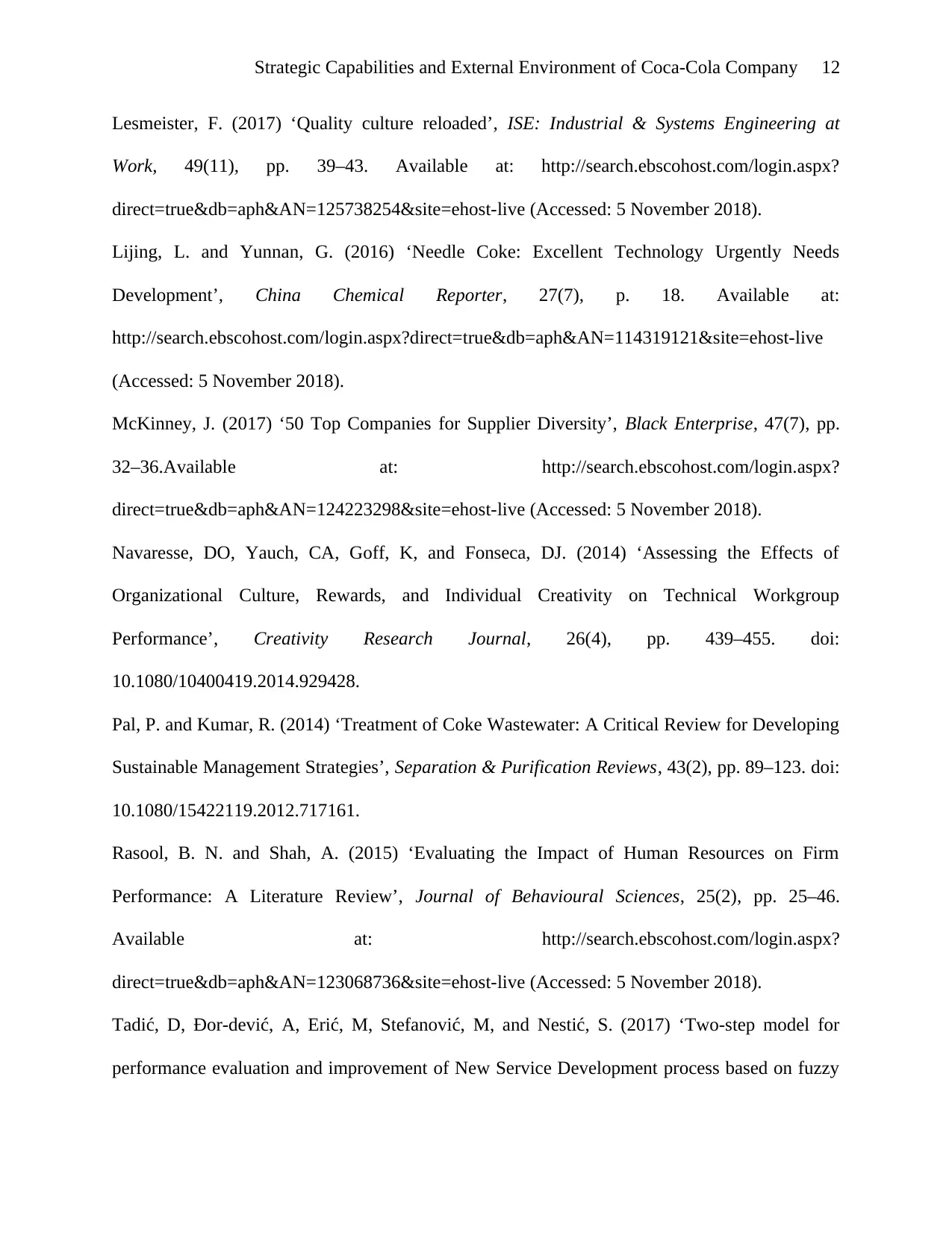
Strategic Capabilities and External Environment of Coca-Cola Company 12
Lesmeister, F. (2017) ‘Quality culture reloaded’, ISE: Industrial & Systems Engineering at
Work, 49(11), pp. 39–43. Available at: http://search.ebscohost.com/login.aspx?
direct=true&db=aph&AN=125738254&site=ehost-live (Accessed: 5 November 2018).
Lijing, L. and Yunnan, G. (2016) ‘Needle Coke: Excellent Technology Urgently Needs
Development’, China Chemical Reporter, 27(7), p. 18. Available at:
http://search.ebscohost.com/login.aspx?direct=true&db=aph&AN=114319121&site=ehost-live
(Accessed: 5 November 2018).
McKinney, J. (2017) ‘50 Top Companies for Supplier Diversity’, Black Enterprise, 47(7), pp.
32–36.Available at: http://search.ebscohost.com/login.aspx?
direct=true&db=aph&AN=124223298&site=ehost-live (Accessed: 5 November 2018).
Navaresse, DO, Yauch, CA, Goff, K, and Fonseca, DJ. (2014) ‘Assessing the Effects of
Organizational Culture, Rewards, and Individual Creativity on Technical Workgroup
Performance’, Creativity Research Journal, 26(4), pp. 439–455. doi:
10.1080/10400419.2014.929428.
Pal, P. and Kumar, R. (2014) ‘Treatment of Coke Wastewater: A Critical Review for Developing
Sustainable Management Strategies’, Separation & Purification Reviews, 43(2), pp. 89–123. doi:
10.1080/15422119.2012.717161.
Rasool, B. N. and Shah, A. (2015) ‘Evaluating the Impact of Human Resources on Firm
Performance: A Literature Review’, Journal of Behavioural Sciences, 25(2), pp. 25–46.
Available at: http://search.ebscohost.com/login.aspx?
direct=true&db=aph&AN=123068736&site=ehost-live (Accessed: 5 November 2018).
Tadić, D, Ðor-dević, A, Erić, M, Stefanović, M, and Nestić, S. (2017) ‘Two-step model for
performance evaluation and improvement of New Service Development process based on fuzzy
Lesmeister, F. (2017) ‘Quality culture reloaded’, ISE: Industrial & Systems Engineering at
Work, 49(11), pp. 39–43. Available at: http://search.ebscohost.com/login.aspx?
direct=true&db=aph&AN=125738254&site=ehost-live (Accessed: 5 November 2018).
Lijing, L. and Yunnan, G. (2016) ‘Needle Coke: Excellent Technology Urgently Needs
Development’, China Chemical Reporter, 27(7), p. 18. Available at:
http://search.ebscohost.com/login.aspx?direct=true&db=aph&AN=114319121&site=ehost-live
(Accessed: 5 November 2018).
McKinney, J. (2017) ‘50 Top Companies for Supplier Diversity’, Black Enterprise, 47(7), pp.
32–36.Available at: http://search.ebscohost.com/login.aspx?
direct=true&db=aph&AN=124223298&site=ehost-live (Accessed: 5 November 2018).
Navaresse, DO, Yauch, CA, Goff, K, and Fonseca, DJ. (2014) ‘Assessing the Effects of
Organizational Culture, Rewards, and Individual Creativity on Technical Workgroup
Performance’, Creativity Research Journal, 26(4), pp. 439–455. doi:
10.1080/10400419.2014.929428.
Pal, P. and Kumar, R. (2014) ‘Treatment of Coke Wastewater: A Critical Review for Developing
Sustainable Management Strategies’, Separation & Purification Reviews, 43(2), pp. 89–123. doi:
10.1080/15422119.2012.717161.
Rasool, B. N. and Shah, A. (2015) ‘Evaluating the Impact of Human Resources on Firm
Performance: A Literature Review’, Journal of Behavioural Sciences, 25(2), pp. 25–46.
Available at: http://search.ebscohost.com/login.aspx?
direct=true&db=aph&AN=123068736&site=ehost-live (Accessed: 5 November 2018).
Tadić, D, Ðor-dević, A, Erić, M, Stefanović, M, and Nestić, S. (2017) ‘Two-step model for
performance evaluation and improvement of New Service Development process based on fuzzy
⊘ This is a preview!⊘
Do you want full access?
Subscribe today to unlock all pages.

Trusted by 1+ million students worldwide
1 out of 13
Related Documents
Your All-in-One AI-Powered Toolkit for Academic Success.
+13062052269
info@desklib.com
Available 24*7 on WhatsApp / Email
![[object Object]](/_next/static/media/star-bottom.7253800d.svg)
Unlock your academic potential
Copyright © 2020–2025 A2Z Services. All Rights Reserved. Developed and managed by ZUCOL.





